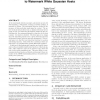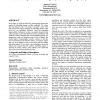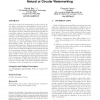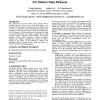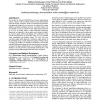MMSEC
2006
ACM
14 years 5 months ago
2006
ACM
Two different approaches for constructing a steganographic channel in an IEEE 802.11 (WLAN) network are introduced in this paper. First test results on the reliability, undetectab...
MMSEC
2006
ACM
14 years 5 months ago
2006
ACM
MMSEC
2006
ACM
14 years 5 months ago
2006
ACM
A novel information-hiding methodology denoted as digital invisible ink is introduced. The proposed approach is inspired by the invisible ink in the real world and can be regarded...
MMSEC
2006
ACM
14 years 5 months ago
2006
ACM
In the watermark detection scenario, also known as zero-bit watermarking, a watermark, carrying no hidden message, is inserted in content. The watermark detector checks for the pr...
MMSEC
2006
ACM
14 years 5 months ago
2006
ACM
In this paper, we study the trade-off in steganography between the number of embedding changes and their amplitude. We assume that each element of the cover image is assigned a sc...
MMSEC
2006
ACM
14 years 5 months ago
2006
ACM
MMSEC
2006
ACM
14 years 5 months ago
2006
ACM
The commercial reuse of 3D motion capture (Mocap) data in animation and life sciences raises issues with respect to its copyright. In order to improvise content protection of Moca...
MMSEC
2006
ACM
14 years 5 months ago
2006
ACM
The widespread use of the Internet makes software piracy and unauthorized modification easier and more frequent. Among the many techniques developed for protecting software copyr...
MMSEC
2006
ACM
14 years 5 months ago
2006
ACM
Current zero-knowledge watermark detectors are based on a linear correlation between the asset features and a given secret sequence. This detection function is susceptible of bein...
MMSEC
2006
ACM
14 years 5 months ago
2006
ACM
We present an efficient JPEG2000-based image authentication scheme, which is robust to JPEG compression and other allowed signal processing operations. Positive wavelet-based wate...

